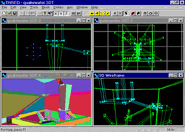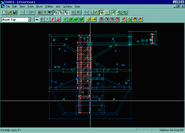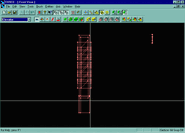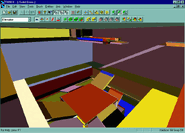THRED (THRee-d EDitor) is an editor for Quake made in early 1996 by Johnathan Mavor. Previously being the main programmer for Neural Storm Entertainment, the company that created Radix: Beyond the Void, he found himself without a team after the game's commercial failure in December of 1995. While he was hired by Cavedog to work on Total Annihilation, the company was mostly busy with paperwork, resulting in a lot of downtime. Mavor therefore decided to start a programming project. Near the end of development of Radix: Beyond the Void, the team wished to create a world with 3D environments but was limited to the 2D CAD based engine Mavor had written up. Therefore, Mavor realized that the next phase of technical progression would be a full 3D game and decided to challenge himself to make something on the cutting edge.
Mavor started by making an editor that could create basic polygonal shapes and allowed for simple movement in a 3D environment. He then began adding Constructive solid geometry, which essentially allows shapes to be merged together in various ways to create surfaces that appear to be more complex than they really are (this essentially became the basis for the .BSP file format). This concept was gaining a lot of traction during Quake's development. It took about a week to construct and was designed as a generic editor not tied to any game.
Jim Lowell, one of the few fans of Radix: Beyond the Void was shown the editor, and suggested that it could be used to create new Quake levels. Quake was not out at the time, only Qtest, which meant that Mavor had some idea how the final product would function. Within a short period of time after the release of Qtest, Lowell had already posted screenshots of an alpha of THRED including images of an early version of DMAS06: King Of The Castle made by Mavor called "quakewater". This resulted in a great amount of popularity in the community, THRED was the first editor for Quake that was made known to the public, the screenshots appearing before the source code of QuakeEd being released online. As most people had to rely on text editors, this caused a stir as one of the first known full-3D editors.
John Carmack contacted Mavor during this time, asking how he managed to get around the protection that prevented people from playing custom levels of Quake without a fully-registered copy. As Mavor didn't need to do anything to get around said protection, Carmack realized that he had erred in his third party protection. Too late to prevent due to the upsurge of custom levels, many early levels for Quake essentially asked the player to purchase the registered version while having no true way from preventing the player using the unregistered copy. This resulted in Mavor getting a registered copy of Quake from id Software.
While THRED gained a lot of publicity, Mavor was relatively uninterested due to it being a side project while waiting for Cavedog to get to the development phase. Steve Foust from Minnesota, part of HeadGames Publishing, Inc., contacted Mavor and told him he would pay a considerable sum of money upfront to not have THRED immediately released. Instead HeadGames would make their own level pack for Quake, Aftershock for Quake, utilizing the powerful technology that nobody else at the time had access to. This gave them an advantage against the competition, which would in turn allow Aftershock to become more popular than other commercial add-ons of the time. THRED was also licensed by the company.
While HeadGames Publishing, Inc. prevented public releases of THRED after the deal was made, there appears to have been a couple releases in September of 1996. The most recent prior to the deal being made would be 0.6b, which was released on September 27, 1996. Note that this means the version released with Aftershock for Quake was a slight update to the one released for free two months prior.
After the release of Aftershock for Quake, Mavor was allowed to distribute THRED to the general public. Though one of the parts of the agreement states that the user must not sell the level for commercial purposes, Mavor mostly permitted said levels. He mostly asked that users approach him on a case-by-case basis so that he had some idea what was being commercially sold with his editor. If a game company wished to use THRED to make their own game, he did desire compensation.
Mavor also was asked to write a book on THRED, though he did not feel confident enough to do such. In hindsight, he considers this to be a good choice on the basis that publishers get extremely small royalties in what is already a market known for not making a lot of money. The creation of this editor resulted in Mavor gaining a lot of notoriety, but he is not as proud with his choices here as he feels he was not a good negotiator. Regardless, Mavor considers THRED to be the program that put him in a situation for the first time in his life with financial stability.
While the Quake community heavily embraced THRED, Mavor just considered it a tool to learn about 3D editing. Being part of Cavedog still and games getting close to production, he started losing interest in the project. Jim Lowell became the main supporter of THRED, announcing new releases and maintaining the distribution of the editor. Lowell was also responsible for any documentation on THRED. Mavor did release a couple versions with expanded features and suggested a 1.0 release with better entity support, better functionality for grouping, gamma correction, and keyboard shortcuts in January of 1997. However, Mavor started getting more busy at Cavedog and so stopped updating THRED or informing Jim Lowell of the situation. Mavor became convinced that Total Annihilation was the next big thing, especially due to being heavily influenced by Command & Conquer, a series Mavor was fond of. The design of THRED did influence Eden, the editor used during the creation of the cancelled game Amen: The Awakening.
In early 1997, THRED was essentially an outdated editor. There was no way to undo/redo actions, plus other editors had been released with a greater amount of controls and user friendliness. By April, Lowell realized that THRED would most likely not be getting another update. Lowell announced to the world in a blog post - "The "official" status of THRED is that there will be another version released. The "Jim Lowell" status is that THRED is dead."
A common name used for THRED levels without a name is Entering JONLEVEL, resulting in numerous levels with this name.
Version History
0.8b - December 11, 1996
- One of the grouping buttons has been removed from the toolbar; in 0.65 it did not have a tooltip or clear defined purpose, nor was there any menu bar option for it.
- The button for group transformations now functions. Clicking this button allows the user to transform (translate, rotate, scale, skew) the currently active group instead of the new brush.
- Limitation for free distribution lifted, but it was forbidden to be distributed by retail or CD beyond the copy found on the Aftershock Toolbox.
- Maps can be made commercially; they can be put on commercial Quake servers or sold as retail levels.
- Unlike 0.65b, this version is supported by Jim Lowell.
- Documentation still was identical to the 0.6b version.
0.65b - November 10, 1996
- Could not be distributed in any way beyond the Aftershock for Quake CD.
- This version was identical to the earlier 0.6b release, even including identical documentation. If there was a minor bug fix, it wasn't documented.
0.6b - September 27, 1996
- Fixed a bug involving saving entities.
0.5b - September 23, 1996
- Original release.













